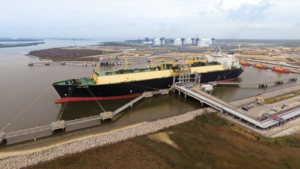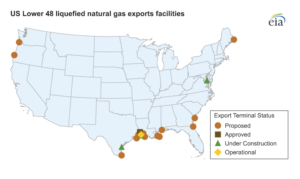As US LNG exports ramp up, increasing gas demand could mean higher rig counts for land drillers
Breakeven price for US onshore dry gas production forecast to be reached early next year, likely to incentivize more drilling activity
By Alex Endress, Editorial Coordinator

The US Lower 48’s first liquefied natural gas (LNG) export, which left the Sabine Pass LNG liquefaction and purification plant, or “train,” in February, was a milestone that was empowered by the US shale revolution. As the US begins to build additional LNG trains – a second has been completed and five more are under construction – it will be up to the onshore drilling industry to support increasing exports by drilling more wells. “It’s one of the larger sources of growing demand that we see for natural gas, which is one factor that could make it more attractive for operators to drill wells,” John Krohn, Communications Manager for the US Energy Information Administration (EIA), said.
After completing the Lower 48’s first LNG export facility at Sabine Pass in Cameron Parish, La., Cheniere Energy recently completed a second LNG train at Sabine Pass. According to the company, the two trains at Sabine Pass are now producing approximately 1 billion cu ft (bcf) of LNG per day and have sent 32 cargos to market as of September. “Those cargos have not just penetrated the proximate markets, such as Europe or South America. LNG from our facilities has ended up in China, India and the Middle East,” Oliver Tuckerman, Director of Strategy and Analytics for Cheniere, said at the 2016 Deloitte Oil & Gas Conference in Houston on 21 September. “So US LNG is truly penetrating global markets.”
Cheniere currently has five more LNG trains under construction and four that are awaiting commercialization along the Gulf Coast – at Sabine Pass and at a new export terminal under construction in Corpus Christi, Texas. Once all are operational, the trains will have a daily export capacity of 4.5 bcf. However, Cheniere isn’t the only company developing LNG terminals in the Lower 48:
• Dominion Energy is scheduled to complete a train at the Cove Point LNG facility in Maryland near the end of 2017;
• Sempra Energy is expected to complete three trains at the Cameron LNG terminal in Hackberry, La., by 2018; and
• Freeport LNG has three trains to be completed by 2020 in Freeport, Texas.
If all projects are completed as scheduled, the US Lower 48 will have an export capacity of 9 bcf/day by the end of the decade, Mr Tuckerman said.

“If you look at the reason that these terminals are here, or are even being considered, it is mainly a result of the increase in natural gas production created by drilling natural gas wells in shale basins and using hydraulic fracturing to extract that resource,” Mr Krohn said. In the decade from 2005 to 2015, US natural gas production grew from 18.9 million cu ft to 28.75 million cu ft, driven by the prolific unconventional shale plays. “That’s the genesis of these facilities,” he said. “Our projections show that LNG exports will continue to grow through 2020. This could help put upward pressure on prices, which could result in exploration and production companies drilling additional wells.”
The EIA expects the US to become a net exporter of LNG by Q2 2017. “We still import natural gas from Canada for power-generation needs in the Northeast where there isn’t a robust pipeline network to source it from other places because the major shale production has just come online within the past three to five years,” Mr Krohn said. EIA statistics show that the US imported 0.25 bcf/day of LNG last year. But by 2017, it’s expected that the US will be exporting an average 1.3 bcf/day.

S&P Global Platts forecasts the average natural gas spot price at Henry Hub will increase from $2.96/mmbtu as of late September to $3.32/mmbtu by December, and will average $3.33/mmbtu in 2017. “The increase of LNG exports coming from the US adds to the demand and the support in prices,” said Javier Díaz, Manager, Energy Analysis and Consulting at Platts. Other factors contributing to pressure on pricing include a stronger residential demand compared to the warm previous winter, as well as growth in natural gas demand from the industrial sectors and from Mexico, to which the US supplies natural gas via pipeline.
Mr Díaz estimates the average breakeven price for US onshore dry gas production to be $3.38/mmbtu, which could be reached by early 2017. “That is when you will have a return of drilling activity because the average rate of return will go high enough to incentivize it.” However, operators may not need as many wells to meet production goals in the coming years. Since 2000, companies have nearly perfected horizontal drilling and hydraulic fracturing operations. For example, back in Q1 2013, dry gas production in the Marcellus averaged 5 mcf/day, and each well required an average of 16 days to drill. By Q4 2015, production had increased to 10 mcf/day, and average drilling time decreased to 12 days, Mr Díaz said.
Although such efficiency gains may mean fewer wells will be needed to hit natural gas production targets, Platts still expects the projected increase in natural gas prices to positively affect rig counts. The company expects the average 2017 US natural gas rig count to increase from 111 in 2016 to 146, representing a 32% increase. “For the next year, we will see an increase in activity in the Northeast and probably the Haynesville, where the economics look better for dry gas plays.” US production is expected to grow by 2.4 bcf/day next year, with most of the growth coming from the Northeast, Mr Díaz said.
Natural gas is also gaining on coal power market share. While coal had been the top source of US power since the EIA began tracking it in 1973, natural gas surpassed coal for the first time on a monthly basis in April, with 33% of the US power market share versus 32% for coal power generation. Cheniere has said that it expects natural gas to continue gaining market share from coal worldwide as more countries seek to reduce carbon emissions.
“You have to look no further than the COP21 event in Paris in December 2015 when 195 countries collectively agreed in principle to prevent global temperatures from increasing by more than 2˚C by the end of the century,” Mr Tuckerman said. He noted that natural gas power emits 50% less carbon dioxide than coal power does; it also reduces other particulate pollutants, such as sulfur oxide and nitrous oxide. “US carbon dioxide emissions are close to 1990 levels, and that is primarily driven by the fact that natural gas has taken 15 points of market share from coal in the US. Natural gas is certainly a solution for addressing climate change.” DC




